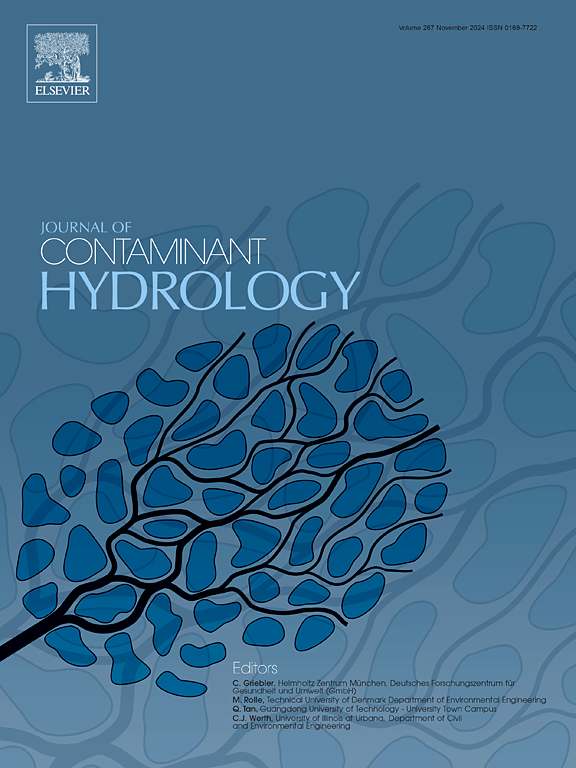通过分布模式和沉降动力学模型评估多阶段处理单元中微塑料的命运
IF 4.4
3区 环境科学与生态学
Q2 ENVIRONMENTAL SCIENCES
引用次数: 0
摘要
微塑料(MPs)是由于人类活动在污水处理厂(WWTPs)中发现的一种全球关注的新污染物,它具有双重功能,是天然水和污泥基应用的关键屏障和途径。本研究全面评估了多阶段处理单元中MPs的命运,包括水和污泥阶段。它应用多样性评估(Simpson多样性指数[SDI]、Shannon-Wiener多样性指数[SWDI]和主成分分析[PCA])和沉降动力学模型(质量平衡模型[MBM]和终端沉降速度模型[TSVM])。结果表明,水相和污泥相的MPs浓度分别为2 ~ 1152项/L和35.65 ~ 85.05 × 103项/kg DW。桃园污水处理厂经亚硝酸盐-反硝化-除磷(TNCU)工艺处理后,MPs去除率达97.42%。尽管有如此高的去除率,但在水相(35.36%和14.25%)和污泥相(21.06%和17.26%)中,纤维和碎片主要是MPs,它们的尺寸大多为50-125 μm。进一步确认两种基质中的聚合物特征表明,人造丝(51.12%)和聚苯乙烯(36.59%)分别占主导地位。随后,多样性评估显示,污泥阶段的MPs特征比水阶段的变化和均匀性更大。同时,PCA结果显示,特定的MP特征(如形状、大小、聚合物类型)显著影响了它们在治疗阶段的分组模式。在本研究实施的沉降动力学命运模型中,MBM证实了MPs在污泥阶段积累,而TSVM表明MPs的沉降机制受其大小和密度的强烈影响。这些发现为了解污水处理厂中MPs的命运和行为提供了新的见解,支持制定更有效的缓解策略。本文章由计算机程序翻译,如有差异,请以英文原文为准。

Assessing the fate of microplastics in multi-stage treatment units through distribution patterns and settling dynamics models
Microplastics (MPs) are a new contaminant of global concern that have been found in wastewater treatment plants (WWTPs) as a result of human activities, which serve a dual function as critical barriers and pathways to natural waters and sludge-based applications. This study comprehensively evaluates the fate of MPs in multi-stage treatment units, covering both the water and sludge phases. It applies diversity assessments (Simpson Diversity Index [SDI], Shannon-Wiener Diversity Index [SWDI], and Principal Component Analysis [PCA]) and settling dynamics models (Mass Balance Model [MBM] and Terminal Settling Velocity Model [TSVM]). It was found that the concentration of MPs in water and sludge phases ranged from 2 to 1152 items/L and 35.65–85.05 × 103 items/kg DW, respectively. MPs removal at the Taoyuan WWTP achieved 97.42 % after nitrite-denitrification and phosphorus removal (TNCU) processes. Despite these high removal rates, fibers and fragments dominate the MPs in the water phases (35.36 % and 14.25 %) and sludge phases (21.06 % and 17.26 %), which are mostly 50–125 μm in size. Further confirmation of the polymer characteristics in both matrices revealed that rayon (51.12 %) and polystyrene (36.59 %) were dominant, respectively. Subsequently, the diversity assessments showed greater variation and homogeneity of MPs characteristics in the sludge phases than in the water phases. Meanwhile, PCA results showed that specific MP characteristics (e.g., shape, size, polymer type) significantly influenced their grouping patterns across treatment stages. Among settling dynamics fate models implemented in this study, MBM confirmed that MPs are accumulated in the sludge phases, while TSVM indicated that the settling mechanisms of MPs was strongly influenced by their size and density. These findings offer new insights into MPs' fate and behavior in WWTPs, supporting the development of more effective mitigation strategies.
求助全文
通过发布文献求助,成功后即可免费获取论文全文。
去求助
来源期刊

Journal of contaminant hydrology
环境科学-地球科学综合
CiteScore
6.80
自引率
2.80%
发文量
129
审稿时长
68 days
期刊介绍:
The Journal of Contaminant Hydrology is an international journal publishing scientific articles pertaining to the contamination of subsurface water resources. Emphasis is placed on investigations of the physical, chemical, and biological processes influencing the behavior and fate of organic and inorganic contaminants in the unsaturated (vadose) and saturated (groundwater) zones, as well as at groundwater-surface water interfaces. The ecological impacts of contaminants transported both from and to aquifers are of interest. Articles on contamination of surface water only, without a link to groundwater, are out of the scope. Broad latitude is allowed in identifying contaminants of interest, and include legacy and emerging pollutants, nutrients, nanoparticles, pathogenic microorganisms (e.g., bacteria, viruses, protozoa), microplastics, and various constituents associated with energy production (e.g., methane, carbon dioxide, hydrogen sulfide).
The journal''s scope embraces a wide range of topics including: experimental investigations of contaminant sorption, diffusion, transformation, volatilization and transport in the surface and subsurface; characterization of soil and aquifer properties only as they influence contaminant behavior; development and testing of mathematical models of contaminant behaviour; innovative techniques for restoration of contaminated sites; development of new tools or techniques for monitoring the extent of soil and groundwater contamination; transformation of contaminants in the hyporheic zone; effects of contaminants traversing the hyporheic zone on surface water and groundwater ecosystems; subsurface carbon sequestration and/or turnover; and migration of fluids associated with energy production into groundwater.
 求助内容:
求助内容: 应助结果提醒方式:
应助结果提醒方式:


